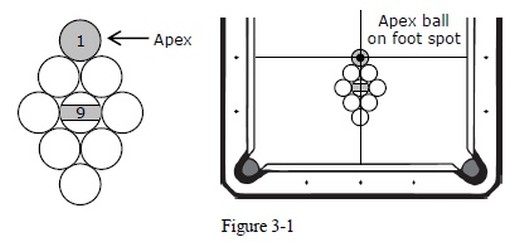Ligue de Billard de Montreal
Main menu
- Accueil
- League Info
- Emplacements
- Photos/Videos
- Documents
- Links
- Contactez Nous
- Referree Zone
9 Ball Rules
3-
9-
3.2 9-
The balls are racked as follows (see Figure 3-
a. in a diamond shape with the 1-
b. the rows behind the apex are parallel to the foot string;
c. the 9-
d. the remaining balls are placed at random.
3-
1. You begin the break with ball in hand behind the head string. The cue ball must contact the 1-
2. Jumped object balls other than the 9-
3. If you legally pocket a ball, you continue to shoot. Your inning ends if you do not pocket a ball or if you foul. If you legally pocket the 9-
3-
1. If there was no foul on the break, the player taking the first shot after the break has the option to shoot a push-
a. you must notify your opponent before the shot and your opponent must acknowledge your intention;
b. the cue ball does not have to contact the lowest numbered ball first, or any object ball at all;
c. no ball has to contact a cushion
d. all other rules and fouls still apply.
2. Any object balls except the 9-
3. After a push-
a. accept the table in position and shoot;
b. require you to shoot again with the table in position.
If you push-
3-
1. After the break (and push-
a. the lowest numbered ball on the table must be the first object ball contacted by the cue ball or it is a foul;
b. if you legally pocket any ball your inning must continue;
c. the 9-
d. other jumped object balls and illegally pocketed balls are not returned to the table.
2. When it is your inning, you must continue to shoot as long as you legally pocket a ball on each shot. Your inning ends if you do not legally pocket a ball.
3. The game is won by the player who legally pockets the 9-
3-
You lose the game if you commit three successive fouls in one game.
3-
If a referee judges that the game is not progressing because the position of the table has not significantly changed through three consecutive innings by each player, the referee will declare a stalemate and the game will be replayed with the player who broke the game breaking again. (AR p. 103)